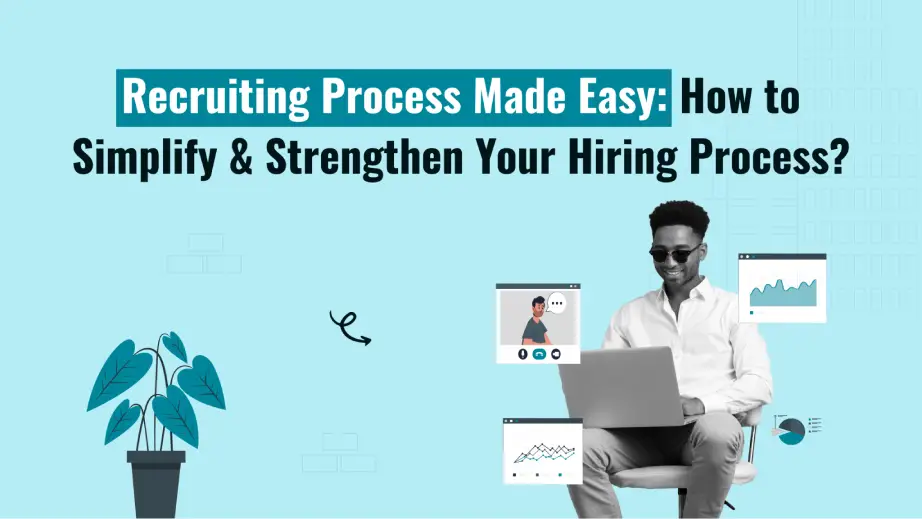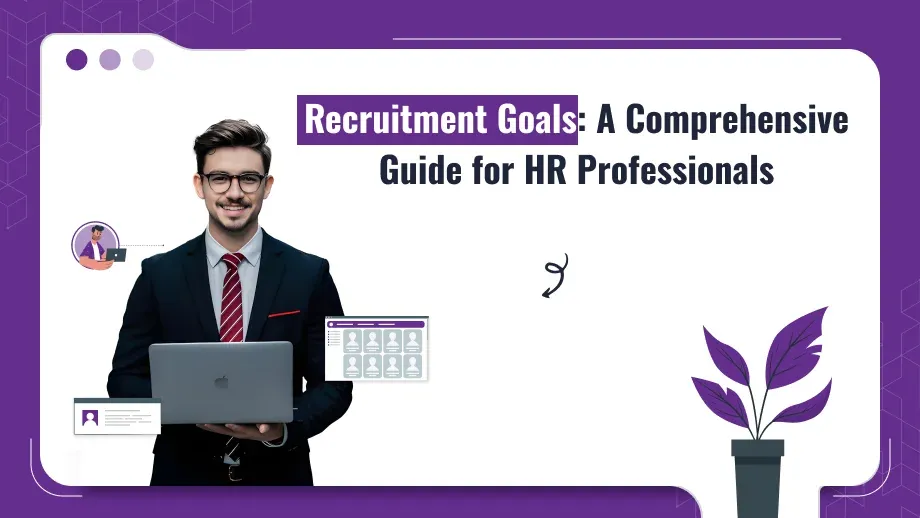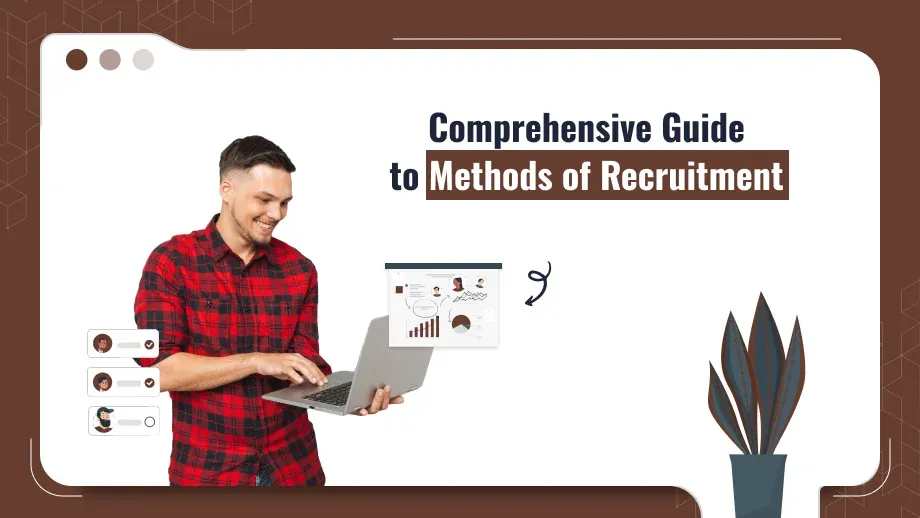Grab a chance to avail 6 Months of Performance Module for FREE
Book a free demo session & learn more about it!
-
Will customized solution for your needs
-
Empowering users with user-friendly features
-
Driving success across diverse industries, everywhere.
Grab a chance to avail 6 Months of Performance Module for FREE
Book a free demo session & learn more about it!
Superworks
Modern HR Workplace
Your Partner in the entire Employee Life Cycle
From recruitment to retirement manage every stage of employee lifecycle with ease.


Seamless onboarding & offboarding
Automated compliance & payroll
Track performance & engagement
Recruiting Process Made Easy: How to Simplify & Strengthen Your Hiring Process?
- recruitment sourcing tools
- 18 min read
- June 21, 2023

Did you know that the average cost of a bad hire can exceed 30% of the employee’s first-year earnings? Now, imagine the impact of multiple bad hires on your organization’s bottom line.
Recruiting process top talent is undeniably crucial for business success, but it often feels like navigating a maze filled with uncertainties.
In this blog, we unveil the secrets to simplifying and strengthening your recruiting process, ensuring that you find the perfect candidates while minimizing costly mistakes. From rethinking traditional recruitment methods to embracing innovative technologies, join us as we explore game-changing strategies that will revolutionize your approach towards Talent Acquisition Software to Improve Hiring Outcomes.
Let’s dive in and unlock the potential of a streamlined, efficient, and successful recruitment journey.
- Importance of The Recruitment Process
- 7-Step Recruitment Process for 5X Candidate Conversion Rate & Candidate Experience
- The Job Description Technique – Do’s and Don’ts!
- Where Should You Look for Passive Candidates?
- 5 Benefits of an Effective & Comprehensive Recruitment Process
- 5 Steps to Screen or Shortlist Candidates in the Recruitment Process
- How Can You Oragnize Your HR Recruiting Process Flows?
- What Are the Two Sources of Recruitment?
- Want an All-In-One System That Fulfills All Your Recruiting Needs?
- Parting Thoughts
Importance of The Recruitment Process
The recruiting process plays a pivotal role in the success of any organization. Recruitment requisition is the foundation upon which a company builds its workforce, and getting it right is paramount.
An effective recruiting process ensures that the right talent is identified, attracted, and ultimately hired. By carefully selecting candidates with the necessary skills, experience, and cultural fit, organizations can enhance productivity, drive innovation, and foster a positive work environment.
Moreover, a well-executed HR recruitment process minimizes employee turnover, reduces hiring costs, and saves valuable time. It is the key to building a strong and cohesive team that can propel the organization towards its goals. Simply put, the recruitment process in HR is the gateway to a thriving and sustainable workforce.
Now that you know what the recruitment process is and why it is important, let’s discuss how to improve hiring process effortlessly!
7-Step Recruitment Process for 5X Candidate Conversion Rate & Candidate Experience
Now that you know the importance of the recruiting process, let’s know the seven step process to boost your candidate conversion rate and candidate experience :
1. Clear Job Description:
A clear job description sets the foundation for a successful recruitment process. It serves as a roadmap, outlining the key responsibilities, qualifications, and expectations for the role.
By providing a comprehensive overview, it attracts candidates who possess the necessary skills and experience, while deterring those who may not be a good fit. A well-crafted job description also helps manage candidate expectations, ensuring they have a clear understanding of the position’s requirements and the company’s values.
Clarity in the job description saves time for both recruiters and applicants, resulting in a more efficient and targeted selection process, ultimately improving the overall quality of hires.
2. Targeted Sourcing:
Targeted sourcing is a vital step in the recruitment process that maximizes the chances of finding the right candidates. It involves strategically identifying and utilizing the most effective channels to reach and engage with the desired talent pool.
By tailoring sourcing strategies based on the role and target audience, recruiters can tap into job boards, professional networks, industry-specific platforms, and social media channels to attract qualified candidates. This approach ensures that the recruitment efforts are focused, efficient, and yield a higher quality applicant pool.
Targeted sourcing also allows for personalization and customization in candidate outreach, enhancing the overall candidate experience and increasing the likelihood of attracting top talent to your organization.
3. Streamlined Application Process:
A streamlined application process is crucial for improving the candidate experience and increasing conversion rates.
Simplifying the application process eliminates unnecessary barriers and reduces candidate drop-off. Optimize your application form for a seamless user experience, making it mobile-friendly and user-friendly. Minimize the number of required fields to only essential information, and offer the option for candidates to upload their resumes with resume management tool or import data from professional profiles.
Additionally, provide clear instructions and guidance throughout the process. By making the application process quick, intuitive, and hassle-free, you create a positive first impression, attracting more candidates and increasing the likelihood of high-quality applicants completing the application successfully.
4. Effective Screening:
Effective screening is a crucial step in the recruitment process that enables you to identify the most qualified candidates efficiently. Implementing a structured screening process helps you assess candidates objectively and make informed decisions.
Utilize pre-screening questionnaires or assessments to evaluate candidates’ skills, qualifications, and job fit. This enables you to filter out candidates who don’t meet the minimum requirements early on, saving time for both parties. Additionally, consider conducting initial phone or video interviews to further evaluate candidates with employee evaluation tool, communication skills and cultural fit.
By implementing effective screening methods, you ensure that only the most promising candidates proceed to the next stages, increasing the likelihood of finding the perfect match for your organization.
5. Engaging Interviews:
Engaging interviews are essential for assessing candidates thoroughly and gaining valuable insights beyond their qualifications.
Prepare well-crafted interview questions that go beyond standard inquiries, allowing candidates to showcase their problem-solving abilities, critical thinking, and relevant experiences. Incorporate behavioral and situational questions to gauge how candidates handle real-life scenarios.
Actively listen and engage in meaningful conversations, fostering a comfortable environment that encourages candidates to express themselves authentically.
Additionally, provide candidates with an opportunity to ask questions, demonstrating your commitment to their engagement and demonstrating the organization’s transparency. By conducting engaging interviews, you gain a deeper understanding of candidates’ potential, cultural fit, and overall suitability for the role, ensuring you make informed hiring decisions.
6. Thorough Evaluation:
Thorough evaluation is a critical aspect of the recruitment process that ensures fair and comprehensive assessments of candidates.
Establish clear evaluation criteria beforehand, including technical skills, cultural fit, and potential for growth. Consistency in evaluation allows for objective comparisons among candidates and eliminates bias.
Review resumes, interview notes, and assessment results meticulously, taking into account both qualitative and quantitative data. Consider conducting reference checks to validate information and gain insights from previous employers or colleagues.
By conducting a thorough evaluation, you can make well-informed decisions, select the best-fit candidates, and mitigate the risk of potential mismatches. This approach contributes to building a high-performing and harmonious team within your organization.
7. Positive Candidate Experience:
Creating a positive candidate experience is paramount in today’s competitive job market. Prioritizing candidate experience throughout the recruitment process helps build a strong employer brand and attract top talent.
Keep candidates informed about their progress at each stage, providing timely updates and Real-Time Feedback Offer a transparent and supportive communication channel, promptly addressing any queries or concerns they may have. Personalize interactions to make candidates feel valued and respected, even if they are not selected.
Ensure that the interview process is well-organized, professional, and respectful of candidates’ time.
By delivering a positive candidate experience, you not only enhance your organization’s reputation but also increase the likelihood of attracting high-quality candidates who are more likely to accept job offers and become brand advocates.
The Job Description Technique – Do’s and Don’ts!
Writing an excellent job description is crucial for attracting qualified candidates. Here are some do’s and don’ts to consider:
Do’s:
-
Clearly define the role
Provide a comprehensive overview of the job responsibilities, including specific tasks and expectations.
-
Highlight qualifications
Clearly state the required qualifications, such as education, experience, and skills.
-
Use clear and concise language
Write in a straightforward manner, avoiding jargon or industry-specific terms that may confuse candidates.
-
Emphasize company culture
Describe the company culture, values, and work environment to attract candidates who align with your organization’s ethos.
-
Include benefits and perks
Mention the benefits, perks, and growth opportunities associated with the role to entice candidates.
Don’ts:
-
Use biased language
Avoid gender-biased or discriminatory language that may deter diverse candidates.
-
Overwhelm with unnecessary information
Stick to essential details and avoid overwhelming candidates with excessive requirements or unrelated information.
-
Overwhelm with unnecessary information
Stick to essential details and avoid overwhelming candidates with excessive requirements or unrelated information.
-
Be vague
Clearly define the role and avoid vague descriptions that may confuse candidates.
-
Exclude salary information
Including salary details attracts candidates who are genuinely interested and helps manage expectations.
-
Neglect proofreading
Proofread the job description to ensure it is error-free and presents a professional image.
Where Should You Look for Passive Candidates?
When searching for passive candidates, who are individuals not actively seeking job opportunities, it’s important to explore various channels and platforms. Here are some places where you can look for passive candidates:
1. Professional networking platforms: LinkedIn is a valuable resource for finding passive candidates. Utilize advanced search options, industry-specific groups, and professional networks to identify potential candidates.
2. Industry events and conferences: Attend relevant industry events, conferences, or seminars where professionals in your target field gather. These events provide opportunities to network and connect with passive candidates.
3. Employee referrals: Encourage your current employees to refer talented individuals from their professional networks. They can tap into their connections and recommend potential candidates who may not be actively job hunting.
4. Online communities and forums: Engage in industry-specific online communities and forums, such as Reddit or specialized forums, where professionals in your desired field participate. These platforms can help you discover passive candidates with specialized expertise.
5. Professional associations: Explore professional associations related to the industry or field you are recruiting for. Many associations have member directories or job boards that can help you connect with passive candidates.
6. Social media platforms: Utilize social media platforms like Twitter, Facebook, or Instagram to identify and engage with professionals in your industry. Monitor relevant hashtags, industry groups, or professional communities where passive candidates may participate.
7. Professional networking platforms:Talent sourcing tools: Leverage recruitment sourcing tools and platforms that aggregate candidate profiles from multiple sources. These tools often provide advanced search filters and AI-powered algorithms to identify potential passive candidates.
Also, See: How To A Craft Winning Recruitment Strategy? 5 Best Tips!

Searching for a recruitment system to revamp your Recruiting process?
If you said YES, you should try Super Recruit, one of the top-notch recruitment management software in India. With Super Recruit, you will find no difficulty sourcing candidates, sorting resumes, or selecting the best hires.
If you don’t believe us, take a step ahead and try the software now by taking a-
5 Benefits of an Effective & Comprehensive Recruitment Process
An effective and comprehensive recruitment process offers numerous benefits for organizations. Here are five key advantages:
1. Attracting top Talent:
A well-structured recruitment process helps attract high-quality candidates. By clearly defining job requirements and qualifications, organizations can effectively target and attract candidates who possess the skills and experience needed to excel in the role. This increases the likelihood of finding the best-fit candidates for the organization.
2. Saving time and Resources:
A streamlined recruitment process saves valuable time and resources for both HR teams and hiring managers. By implementing efficient sourcing, screening, and evaluation methods, organizations can reduce time-to-hire and minimize the need for repetitive or unnecessary steps. This allows HR teams and hiring managers to focus their efforts on evaluating and engaging with top candidates.
3. Minimizing employee turnover:
A comprehensive recruitment process aims to identify candidates who not only possess the required skills but also align with the organization’s culture and values. By carefully evaluating cultural fit and assessing candidate motivations, organizations can reduce the risk of hiring mismatches and subsequent employee turnover. This leads to a more stable and engaged workforce.
4. Improving Productivity and Performance:
Hiring the right candidates has a direct impact on productivity and performance. A thorough recruitment process ensures that candidates are evaluated for their competencies and potential contributions to the organization. By selecting candidates with the right skills and qualifications, organizations can enhance productivity, drive innovation, and achieve better overall performance.
5. Enhancing employer brand and reputation:
An effective recruitment process contributes to building a positive employer brand and reputation. When candidates have a positive experience throughout the recruitment journey, they are more likely to speak highly of the organization, whether they are hired or not. This positive word-of-mouth can attract more qualified candidates in the future and enhance the organization’s reputation as an employer of choice.
5 Steps to Screen or Shortlist Candidates in the Recruitment Process
Effectively screening or shortlisting candidates is a crucial step in the recruitment process to identify the most qualified individuals for a job.
Here are five steps to help you streamline this process:
1. Review Resumes and Applications:
Start by carefully reviewing the resumes and applications received from candidates. Look for relevant experience, qualifications, and skills that match the job requirements. Pay attention to factors like education, previous job titles, industry experience, and any specific certifications or achievements mentioned.
2. Conduct phone screenings:
After reviewing the initial applications, consider conducting phone screenings with selected candidates. This step allows you to assess their communication skills, clarify any questions regarding their qualifications, and gain a general sense of their fit for the role. Prepare a set of standardized questions to ask each candidate to ensure fairness and consistency.
3. Use pre-employment assessments:
Utilize pre-employment assessments or tests to evaluate candidates’ skills and abilities in areas relevant to the job. These assessments can range from technical skills tests to personality assessments. Choose assessments that align with the role and job requirements and provide valuable insights into candidates’ capabilities.
4. Conduct structured interviews:
Schedule in-person or virtual interviews with shortlisted candidates. Prepare a list of structured interview questions that assess both job-specific competencies and cultural fit. Incorporate behavioral or situational questions that prompt candidates to provide real-life examples of their problem-solving skills and experience. Use a consistent rating scale or evaluation criteria to objectively assess candidates’ responses.
5. Check references & conduct background checks:
Before making a final decision, reach out to the candidates’ references to verify their qualifications, work history, and overall performance. Additionally, consider conducting auto background checks to verify a candidate’s education and ensure the accuracy of the information provided, confirming the candidates’ eligibility for employment.
How Can You Oragnize Your HR Recruiting Process Flows?
Organizing your HR recruiting process flows is crucial for a smooth and efficient talent acquisition process. Here are some steps to help you organize your HR recruiting process flows effectively:
1. Define the recruitment workflow:
Start by clearly defining the stages and steps involved in your HR recruitment process. Common stages may include job requisition, sourcing, screening, interviewing, reference checks, and offer stage. Create a visual flowchart or document that outlines the sequential order of these stages and the actions required at each step.
2. Establish roles and responsibilities:
Assign specific roles and responsibilities to the individuals involved in the recruitment process. This includes HR personnel, hiring managers, interviewers, and any other stakeholders. Clearly communicate the expectations and responsibilities for each role to ensure accountability and coordination.
3. Utilize an applicant tracking system:
Implement an ATS software, talent acquisition software or one of the best recruitment software in India to streamline and automate various aspects of the recruitment and selection process. An ATS software helps you track and manage candidate data, schedule interviews, communicate with candidates, and collaborate with team members effectively. It also provides valuable analytics and reports features for process evaluation and improvement.
4. Standardize recruitment templates and documents:
Develop standardized templates for job descriptions, interview guides, evaluation forms, offer letters, and other recruitment-related documents. This ensures consistency and eliminates the need to recreate documents from scratch for each hiring process. Standardized templates also help maintain compliance and reduce errors.
5. Communicate and set expectations:
Establish clear communication channels and guidelines for interacting with candidates. Regularly update candidates on the status of their applications, provide feedback after interviews, and promptly respond to inquiries. Set realistic timelines and expectations for each stage of the process to manage candidate experience effectively.
6. Implement feedback loops and continuous improvement:
Regularly seek feedback from stakeholders involved in the recruitment process, including hiring managers, interviewers, and candidates. Review the received feedback as well as recognize improvement areas. Continuously refine your recruitment process flows based on this Real-Time Feedback to enhance efficiency, candidate experience, and the overall quality of hires.
7. Document and train on the process:
Document the recruitment process flows, including all the steps, guidelines, and best practices. Create a comprehensive recruitment process manual or handbook that can be easily accessed and referenced by HR personnel and hiring teams. Provide training and guidance to individuals involved in the recruitment process to ensure they understand and follow the established workflows.
What Are the Two Sources of Recruitment?
The two main sources of recruitment are internal recruitment and external recruitment.
-
Internal Recruitment:
Internal recruitment is the process of filling job vacancies within an organization by considering existing employees for new or vacant positions. It is a valuable source of talent that offers numerous benefits for both employees and the organization.
One of the key advantages of internal recruitment is the opportunity for employee development and career growth. By promoting from within, organizations can nurture and retain talented individuals who already possess a deep understanding of the company culture, values, and processes.
Internal recruitment provides employees with a sense of advancement and recognition, boosting their morale, job satisfaction, and overall loyalty to the organization. It also encourages a culture of continuous learning and skill development, as employees are motivated to enhance their qualifications to compete for internal opportunities.
Internal recruitment also helps to foster a positive work environment and build strong relationships among employees.
When individuals observe their colleagues being promoted or moving up the career ladder, it creates a sense of aspiration and healthy competition. It motivates employees to work hard, develop their skills, and seize growth opportunities within the organization. Internal recruitment promotes a culture of meritocracy and rewards employees based on their performance, further enhancing employee engagement and retention.
Moreover, internal recruitment can result in cost savings for the organization. Hiring externally often involves significant expenses, such as advertising costs, recruitment agency fees, and lengthy employee onboarding processes.
Internal recruitment minimizes these costs by utilizing existing resources and reducing the need for external sourcing. It also avoids potential risks associated with external hires who may not fit well within the organization’s culture or require a longer adjustment period.
Overall, internal recruitment is a valuable strategy for organizations to tap into the talent and potential of their existing workforce.
-
External Recruitment:
External recruitment refers to the process of sourcing and attracting candidates from outside the organization to fill job vacancies. It is an essential strategy that enables organizations to tap into a diverse talent pool and bring in fresh perspectives, skills, and experiences.
One of the primary advantages of external recruitment is the access to a wider range of candidates.
By looking beyond the existing workforce, organizations can bring in individuals with different backgrounds, expertise, and perspectives. This diversity of talent can foster innovation, creativity, and problem-solving within the organization. External recruitment allows organizations to tap into specialized skill sets and industry knowledge that may not be readily available internally.
Additionally, external recruitment brings in new ideas and fresh perspectives. Candidates from external sources often bring experiences from different industries or organizations, allowing for the introduction of innovative approaches and best practices. They can challenge existing norms, drive change, and contribute to the continuous improvement of processes and strategies.
External recruitment also helps to enhance competitiveness in the market. It enables organizations to attract top talent from the industry and gain a competitive edge. By strategically promoting job openings and leveraging various recruitment channels, organizations can position themselves as desirable employers and attract high-caliber candidates who may not have considered internal opportunities.
Want an All-In-One System That Fulfills All Your Recruiting Needs?
If you said YES, you should try Super Recruit.
For the uninitiated, Super Recruit is a one-stop solution to streamline and enhance the recruitment process.
This hr recruiting software comes with a range of powerful features that cater to all your recruiting needs – that too at the best recruiting software price:
1. Interview Scheduler:
Super Recruit simplifies the interview scheduling process by providing an intuitive interface to coordinate interview slots with candidates and hiring managers. Say goodbye to endless email threads and scheduling conflicts as you effortlessly manage interview logistics.
2. Calendar Management:
With Super Recruit’s integrated calendar management, you can keep track of all your recruitment-related appointments, deadlines, and events in one centralized system. Sync your calendars, set reminders, and ensure efficient coordination among team members.
3. Career Page:
Showcase your organization’s culture, values, and job opportunities with customizable recruit career. Create a compelling employer brand and attract top talent by highlighting your unique selling points and providing an engaging candidate experience.
4. Referral Management:
Leverage the power of employee referrals with Super Recruit’s robust referral management feature. Encourage your employees to refer potential candidates through an easy-to-use interface, track referral progress, and reward successful referrals, fostering a culture of employee engagement and talent acquisition.
5. Resume Sorting:
Say goodbye to manual resume screening with Super Recruit’s advanced resume sorting capabilities. The system uses AI-powered algorithms to analyze and categorize resumes based on predefined criteria, saving you valuable time and ensuring a more efficient candidate selection process.
Parting Thoughts
In conclusion, streamlining and reinforcing the recruitment process can bring significant advantages to organizations and improve recruiting process.
We hope the strategies and information we provided in this blog will help you to improve hiring process and reap desired hiring results along the way.
Also, if you wish to try Super Recruit and its exceptional features & benefits – do not hesitate to take a 30-days free trial. The right system will solve all your existing hiring problems and ensure a smoother and smarter recruiting process.











